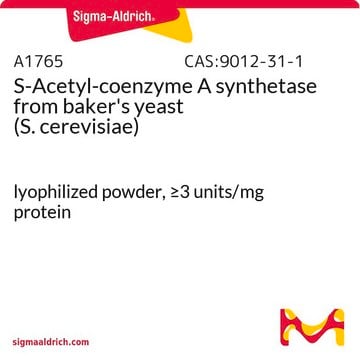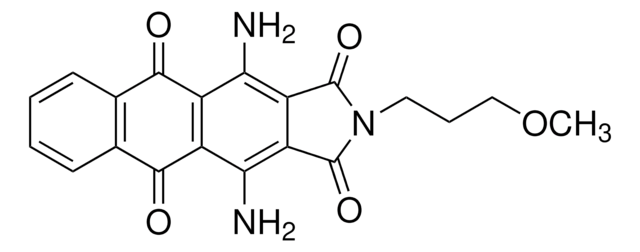C2643
Coenzyme A, oxidized lithium salt
≥85%
Synonym(s):
CoA-S-S-CoA
Select a Size
¥19,390
List Price¥27,700Save 30%Estimated to ship onApril 02, 2025
Select a Size
About This Item
¥19,390
List Price¥27,700Save 30%Estimated to ship onApril 02, 2025
Recommended Products
Quality Level
Assay
≥85%
form
solid
storage temp.
−20°C
SMILES string
[P](=O)(O[P](=O)(OCC([C@@H](O)C(=O)NCCC(=O)NCCSSCCNC(=O)CCNC(=O)[C@H](O)C(CO[P](=O)(O[P](=O)(OC[C@H]4O[C@H]([C@@H]([C@@H]4O[P](=O)(O)O)O)[n]5c6ncnc(c6nc5)N)O)O)(C)C)(C)C)O)(OC[C@H]1O[C@H]([C@@H]([C@@H]1O[P](=O)(O)O)O)[n]2c3ncnc(c3nc2)N)O
InChI
1S/C42H70N14O32P6S2/c1-41(2,15-81-93(75,76)87-91(71,72)79-13-21-29(85-89(65,66)67)27(59)39(83-21)55-19-53-25-33(43)49-17-51-35(25)55)31(61)37(63)47-7-5-23(57)45-9-11-95-96-12-10-46-24(58)6-8-48-38(64)32(62)42(3,4)16-82-94(77,78)88-92(73,74)80-14-22-30(86-90(68,69)70)28(60)40(84-22)56-20-54-26-34(44)50-18-52-36(26)56/h17-22,27-32,39-40,59-62H,5-16H2,1-4H3,(H,45,57)(H,46,58)(H,47,63)(H,48,64)(H,71,72)(H,73,74)(H,75,76)(H,77,78)(H2,43,49,51)(H2,44,50,52)(H2,65,66,67)(H2,68,69,70)/t21-,22-,27-,28-,29-,30-,31+,32+,39-,40-/m1/s1
InChI key
YAISMNQCMHVVLO-ODFVJXNFSA-N
Looking for similar products? Visit Product Comparison Guide
Related Categories
General description
Application
Biochem/physiol Actions
Signal Word
Danger
Hazard Statements
Precautionary Statements
Hazard Classifications
Eye Dam. 1 - Skin Irrit. 2
Storage Class Code
4.1B - Flammable solid hazardous materials
WGK
WGK 3
Flash Point(F)
Not applicable
Flash Point(C)
Not applicable
Regulatory Listings
Regulatory Listings are mainly provided for chemical products. Only limited information can be provided here for non-chemical products. No entry means none of the components are listed. It is the user’s obligation to ensure the safe and legal use of the product.
PDSCL
Deleterious substance
ISHL Notified Names
Substances Subject to be Notified Names
JAN Code
C2643-10MG:4548174016619
C2643-1MG:
C2643-5MG:4548174016626
C2643-BULK:
C2643-VAR:
Choose from one of the most recent versions:
Certificates of Analysis (COA)
Don't see the Right Version?
If you require a particular version, you can look up a specific certificate by the Lot or Batch number.
Already Own This Product?
Find documentation for the products that you have recently purchased in the Document Library.
Customers Also Viewed
Active Filters
Our team of scientists has experience in all areas of research including Life Science, Material Science, Chemical Synthesis, Chromatography, Analytical and many others.
Contact Technical Service










